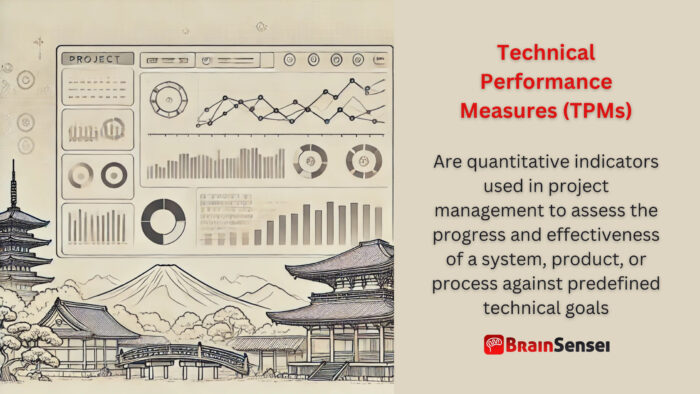
Technical Performance Measures
What Are Technical Performance Measures (TPMs)?
Technical performance measures (TPMs) are quantitative indicators used in project management to assess the progress and effectiveness of a system, product, or process against predefined technical goals. These measures ensure that the project meets performance requirements and aligns with stakeholder expectations.
Key Takeaways
- Objective Assessment: TPMs provide data-driven insights into a project’s technical progress.
- Early Risk Identification: They help identify deviations from performance goals early in the project lifecycle.
- Stakeholder Communication: TPMs enhance transparency by offering measurable benchmarks.
- Quality Assurance: They ensure products meet design, functional, and performance criteria.
- Continuous Improvement: By tracking TPMs, teams can refine processes and mitigate risks.
Understanding Technical Performance Measures (TPMs)
How TPMs Work
TPMs are typically established during the project planning phase and monitored throughout execution. They align with key project objectives, providing an empirical basis for evaluating performance. TPMs can be categorized into:
- System-Level TPMs: Evaluate overall system performance, such as speed, reliability, and efficiency.
- Component-Level TPMs: Assess individual subsystems or components to ensure alignment with overall objectives.
- Process TPMs: Measure the efficiency of workflows and production processes.
- Operational TPMs: Track real-world functionality in end-user environments.
Notes
- TPMs should be quantifiable and measurable for effective tracking.
- Regular reviews help maintain alignment with project goals.
- Over-reliance on TPMs without qualitative analysis can lead to misleading conclusions.
- TPMs should be tailored to project needs to avoid unnecessary complexity.
- Establishing a baseline ensures meaningful performance comparisons.
Related Terms
- Key Performance Indicators (KPIs): These are quantifiable metrics used by companies to gauge the effectiveness of their progress toward critical business targets.
- Earned Value Management (EVM): A technique integrating cost, schedule, and scope to measure project performance.
- Risk Management Metrics: Indicators used to assess project risks and their potential impact.
- Systems Engineering Metrics: These are measures used in complex engineering projects to evaluate technical feasibility.
- Cost Performance Index (CPI): A financial metric assessing the cost efficiency of a project budget.
- Schedule Performance Index (SPI): A measure of schedule adherence based on planned vs. actual progress.
Examples of Technical Performance Measures in Different Industries
Manufacturing & Construction
TPMs track material strength, load-bearing capacity, and environmental resilience in a large-scale bridge construction project. Engineers use stress tests and computational models to ensure compliance with design specifications. For example, they meticulously measure wind resistance, cable tensile strength, and seismic resilience to construct a suspension bridge. If TPMs reveal deviations, they make modifications before construction advances. This iterative process ensures the bridge can withstand natural forces, meet safety regulations, and function effectively for decades.
Engineers use TPMs beyond bridges in skyscraper construction, closely monitoring load distribution, energy efficiency, and fire resistance. They analyze real-time data collected from sensors embedded in materials and make informed decisions about reinforcing structural elements before completing critical phases. Without these TPMs, they might not identify potential design flaws until too late, leading to costly retrofits or safety hazards.
IT & Software Development
A software development team implementing a new cloud platform monitors TPMs such as response time, system uptime, and data throughput. Performance testing, including stress and load testing, ensures the software meets reliability and security standards before deployment. For instance, an e-commerce company launching a high-traffic website must track TPMs like database query performance, API response latency, and page load speed.
Failure to monitor these metrics can lead to system crashes during peak traffic periods, resulting in lost sales and customer dissatisfaction. Continuous integration and automated testing frameworks help development teams quickly identify performance bottlenecks, allowing for proactive optimization. In addition, cybersecurity TPMs—such as intrusion detection efficiency and encryption performance—are crucial for safeguarding user data against cyber threats. Organizations can confidently roll out secure and efficient digital platforms by establishing clear benchmarks.
Healthcare & Pharmaceuticals
TPMs evaluate precision, durability, and compliance with regulatory standards in medical device manufacturing. For example, a new MRI machine undergoes repeated testing to ensure imaging quality and operational safety accuracy. Key TPMs in this scenario include signal-to-noise ratio in scans, electromagnetic interference shielding, and thermal regulation of components.
Beyond equipment manufacturing, TPMs are critical in pharmaceutical production, where drug purity, dosage accuracy, and chemical stability must meet stringent FDA or EMA standards. A real-world case involves insulin production, where TPMs track potency retention under varying temperatures. Any deviation in chemical stability could compromise patient health, making continuous TPM tracking essential. In clinical trials, TPMs such as patient response rates, biomarker variability, and side-effect frequency guide adjustments to drug formulations before regulatory approval.
Energy & Utilities
Power generation facilities rely on TPMs to optimize efficiency, reduce emissions, and maintain regulatory compliance. For example, TPMs track reactor coolant temperature, radiation leakage levels, and turbine efficiency in a nuclear power plant. These measurements ensure the plant operates within safe parameters while maximizing energy output.
TPMs include wind turbine rotational speeds, blade stress levels, and energy conversion efficiency in renewable energy sectors such as wind farms. Engineers use these metrics to optimize turbine placement and maintenance schedules, increasing power generation reliability. Without TPM tracking, unexpected component failures could lead to costly downtime and supply disruptions.
By continuously monitoring TPMs across industries, organizations can identify performance gaps, enhance operational efficiency, and deliver superior products and services. TPMs bridge technical specifications and real-world performance, ensuring project outcomes meet or exceed stakeholder expectations.
Use Cases of Technical Performance Measures
North America (Aerospace Engineering)
NASA extensively uses TPMs to track spacecraft propulsion efficiency, heat resistance, and communication reliability during development. These measures ensure that missions meet stringent safety and performance criteria. For example, when designing a new Mars rover, NASA engineers use TPMs to monitor the durability of its wheels, the efficiency of its power systems, and the reliability of its communication signals. Modifications are made before final deployment if a particular system fails to meet expected performance thresholds.
In addition, TPMs help NASA assess fuel consumption rates and atmospheric entry dynamics for manned and uncrewed missions. Using real-time telemetry data further enables engineers to make critical in-flight adjustments. Without rigorous TPM analysis, spacecraft might encounter mission failure due to unforeseen technical weaknesses, leading to significant financial and scientific setbacks.
Europe (Automotive Industry)
A European car manufacturer leverages TPMs to enhance fuel efficiency, emissions control, and safety features in new vehicle models. Wind tunnel tests, crash simulations, and on-road performance tracking provide engineers with measurable data to refine vehicle designs. Engineers monitor TPMs such as engine heat dissipation, braking response time, and aerodynamic coefficient throughout development.
TPMs play a vital role in meeting stringent European Union emission standards, ensuring that cars maintain compliance with carbon dioxide reduction targets. Manufacturers can fine-tune hybrid and electric vehicle systems for optimal performance by tracking engine efficiency and exhaust output continuously. Without TPMs, new models might fail regulatory assessments, delaying production and increasing costs.
Automated driving technologies rely heavily on TPMs to assess sensor accuracy, lane detection efficiency, and reaction time to obstacles. Self-driving prototypes undergo extensive testing with TPM-driven assessments to validate their real-world applicability before reaching consumers.
Asia (Telecommunications Expansion)
When deploying 5 G infrastructure, a telecommunications provider in Asia evaluates TPMs regarding signal strength, latency, and network coverage. These metrics ensure that network performance meets consumer and enterprise demands. For example, TPMs track base stations’ response time, fibre-optic connections’ capacity, and overall network reliability in urban and rural settings.
In highly populated cities like Tokyo or Shanghai, TPMs help optimize the placement of cell towers to minimize service interruptions. Meanwhile, satellite-based TPMs monitor signal propagation in rural areas to extend coverage where traditional infrastructure is unavailable. Network engineers use these performance measures to make real-time adjustments, such as rerouting traffic during peak hours or increasing bandwidth capacity in high-demand locations.
Security TPMs also play a role in telecom expansion, evaluating the resilience of data encryption methods and intrusion detection systems. With cyber threats rising, providers must constantly measure TPMs related to system vulnerabilities and response times to mitigate risks. A failure to address these technical concerns can lead to widespread service disruptions, data breaches, and regulatory penalties.
Middle East (Oil & Gas Industry)
In the Middle East, where oil and gas production is a significant industry, TPMs optimize drilling efficiency, pipeline integrity, and refinery output. Engineers monitor parameters such as sound pressure, extraction speed, and equipment corrosion rates to prevent operational failures and environmental hazards.
For instance, TPMs track underwater pressure stability and sediment displacement in offshore drilling projects to ensure safety and efficiency. Real-time sensors allow companies to detect potential leaks early, reducing the risk of catastrophic oil spills. Furthermore, refineries rely on TPMs to measure fuel purity levels and energy consumption, maximizing output while minimizing waste.
With the global push toward sustainable energy, oil and gas companies use TPMs to assess carbon capture technologies and alternative fuel efficiency. By refining technical performance metrics, firms can align with global sustainability goals while maintaining profitability.
Conclusion: TPMs are applied across multiple industries, ensuring technical efficiency, regulatory compliance, and overall system reliability. Whether in aerospace, automotive manufacturing, telecommunications, or energy production, TPMs provide essential benchmarks that drive innovation and risk mitigation. Organizations prioritizing TPM tracking can optimize their operations, improve product quality, and deliver superior performance outcomes in an increasingly competitive and regulated global market.
Best Practices for Implementing Technical Performance Measures
To ensure reliability, accuracy, and alignment with project objectives, a structured approach is required to implement TPMs effectively. Below are some best practices to follow:
Define Clear Objectives and Metrics
Before implementing TPMs, organizations must establish clear, measurable objectives aligned with project goals. Metrics should be:
- Specific: Clearly define the aspect of performance the team is measuring..
- Measurable: Quantify the measure to allow for accurate tracking.
- Achievable: Ensure feasibility within the project’s scope and resources.
- Relevant: Align with key performance indicators and project requirements.
- Time-bound: Establish timeframes for assessment to gauge progress effectively.
For example, an IT company developing cloud infrastructure may define TPMs related to server response time, uptime percentage, and latency.
Leverage Data Collection and Monitoring Tools
To ensure consistent tracking and reporting, organizations should use project management and data analytics tools, such as:
- Automated dashboards for real-time performance visualization.
- Machine learning algorithms for predictive performance analysis.
- Internet of Things (IoT) sensors to gather real-time technical data in industrial settings.
- Software-based monitoring tools for system performance tracking.
By leveraging these technologies, organizations can enhance efficiency and minimize errors in TPM measurement.
Establish Baselines and Performance Thresholds
To effectively interpret TPMs, organizations must establish baseline performance levels and acceptable thresholds. This approach helps in:
- Comparing current performance with expected standards.
- Identifying potential issues before they escalate.
- Defining contingency plans for performance deviations.
For instance, in the automotive industry, engineers may design a new hybrid vehicle with a baseline fuel efficiency of 40 miles per gallon. The team can implement corrective actions before production if test results drop below 35 miles per gallon.
Integrate TPMs with Risk Management Processes
By embedding TPMs into risk management strategies, organizations can:
- Identify early warning signs of technical failures.
- Implement mitigation measures proactively.
- Reduce the likelihood of costly redesigns or project delays.
For example, aerospace manufacturers use TPMs to track engine performance under extreme conditions. If engine temperature levels exceed safety thresholds during testing, the design team makes design modifications before full-scale manufacturing.
Ensure Regular Performance Reviews and Adjustments
Teams should conduct regular TPM assessments at predefined intervals to:
- Track deviations from expected performance.
- Adjust benchmarks as technology and project scope evolve.
- Maintain alignment with stakeholder expectations and regulatory standards.
Monthly or quarterly TPM review meetings ensure continuous improvement and agile responses to technical challenges.
Encourage Cross-Functional Collaboration
Effective TPM implementation requires coordination among different teams, including:
- Project managers to align TPMs with business goals.
- Engineers and technical experts to define appropriate metrics.
- Quality assurance teams to validate data accuracy.
- Data analysts to interpret performance trends.
For example, in software development, a collaboration between developers, QA testers, and DevOps engineers ensures that TPMs such as system uptime and bug resolution rates remain optimal.
Adapt TPMs to Evolving Project Needs
As projects progress, technical requirements and performance expectations may change. Organizations should:
- Periodically reassess TPM effectiveness.
- Adjust measurement parameters based on real-world performance.
- Incorporate stakeholder feedback for continuous improvement.
For instance, 5G deployment strategies in telecommunications may require adjusting TPMs to account for higher user demands and network expansion efforts.
Conclusion: Implementing TPMs ensures that organizations can track technical performance accurately, mitigate risks, and achieve project objectives efficiently. By following best practices—such as defining clear goals, leveraging advanced monitoring tools, establishing baselines, and fostering collaboration—businesses can optimize operations and drive sustained success in highly competitive industries.
Technical Performance Measures: Common Mistakes and Issues
Despite the value of TPMs, organizations frequently encounter challenges when implementing and interpreting these measures. Below are some of the most common mistakes and issues associated with TPMs and their impact on project performance.
Failing to Define Clear and Relevant Technical Performance Measures (TPMs)
One of the organizations’ most prominent mistakes is selecting TPMs that are too broad or irrelevant to the project’s technical requirements. If the chosen metrics do not align with actual project objectives, they may provide misleading information or fail to detect critical performance issues.
For instance, a software development company might focus only on system uptime as a TPM while ignoring user latency, resulting in a technically available application that still provides a poor user experience due to slow response times. Multiple stakeholders should carefully define TPMs to prevent this, ensuring they measure aspects critical to project success.
Over-Reliance on a Single TPM
Organizations sometimes rely too heavily on one key technical metric while neglecting others, leading to an incomplete project health assessment. A classic example is manufacturing, where a company may focus solely on production speed without tracking defect rates. The result could be increased output but lower product quality, ultimately causing customer dissatisfaction and increased rework costs.
Organizations should use a balanced approach to mitigate this issue, incorporating multiple TPMs covering technical performance facets, such as reliability, efficiency, and quality control.
Lack of Regular Monitoring and Updates
TPMs are most effective when continuously monitored and adjusted as needed. A common issue is setting TPMs at the start of a project but failing to track them consistently. Without regular performance reviews, teams may not realize when a project deviates from expectations until it is too late.
For example, if builders fail to track material stress tolerance throughout the build phase in large construction projects, structural issues may become apparent only after significant investment. Organizations should establish structured review schedules and adjust TPMs in response to evolving project conditions to ensure relevance.
Inadequate Data Collection and Poor Data Quality
Another significant issue is collecting insufficient or inaccurate data, which leads to unreliable TPM assessments. Poorly calibrated sensors, inconsistent reporting methods, or a lack of standardized data entry processes can result in faulty conclusions and incorrect decision-making.
For example, measuring engine performance using outdated testing equipment in an aerospace project can produce inaccurate fuel efficiency readings. As a result of these inaccurate readings, engineers may make unnecessary design modifications or overlook critical inefficiencies. Implementing high-quality data collection methods and ensuring data integrity are essential for TPM effectiveness.
Failure to Integrate TPMs with Decision-Making
Even when TPMs are well-defined and accurately measured, their effectiveness is limited if organizations do not incorporate them into decision-making processes. TPMs should drive actionable insights, allowing teams to identify risks early and implement course corrections.
A common mistake in IT infrastructure management is that performance monitoring tools generate detailed reports, but leadership fails to act on the findings. If IT teams consistently observe server performance degradation but do not address it, system failures and downtime will impact business operations.
Neglecting the Human Factor in TPM Analysis
While TPMs provide quantitative insights, they do not capture qualitative factors such as team expertise, morale, or operational context. Ignoring these elements can lead to misinterpretation of TPM data.
For example, a company may track the number of resolved bugs in software development as a TPM. However, if developers are overworked and prioritize quantity over quality, the reported TPM may suggest progress while software stability declines. Organizations should supplement TPM data with human insights to get a holistic view of performance.
Conclusion: Common mistakes in Technical Performance Measure implementation can undermine project success, leading to inefficiencies, missed risks, and poor decision-making. Organizations must ensure TPMs are well-defined, monitored consistently, integrated into decision-making, and balanced across multiple performance dimensions. High-quality data collection and human oversight are also necessary to extract meaningful insights. Organizations can fully leverage TPMs to drive better technical performance and project outcomes by addressing these issues.
Technical Performance Measures: Frequently Asked Questions (FAQs)
How do TPMs differ from KPIs?
TPMs focus on technical aspects of performance, while KPIs encompass broader business objectives, including financial and customer satisfaction metrics.
Can Technical Performance Measures (TPMs) be used in Agile project management?
Yes, teams can adapt TPMs to Agile frameworks by continuously measuring technical progress and adjusting goals based on iterative development cycles.
How often should Technical Performance Measures (TPMs) be reviewed?
TPMs should be reviewed regularly at key project milestones or phases to ensure alignment with objectives and early identification of issues.
What tools can teams use to track Technical Performance Measures (TPMs)?
Standard tools include project management software like Microsoft Project, Jira and specialized engineering performance tracking systems.
What happens if Technical Performance Measures (TPMs) indicate poor performance?
To address performance gaps, teams should implement corrective actions, such as design modifications, process optimizations, or resource reallocation.
Additional Resources
- The Ultimate KPI Handbook: Key Performance Indicators for Every Industry
- Project Quality Management, Third Edition: Why, What and How
Preparing for a PMI certification?
- Exam Prep Courses: PMP®, CAPM®, and PMI-ACP®
- Exam Simulators: PMP®, CAPM®, PMI-ACP®, PMI-PBA®, PMI-RMP®, PMI-SP®, PgMP®, and PfMP®
- Professional Development Units (PDUs): 15, 30, and 60 PDU Bundles



